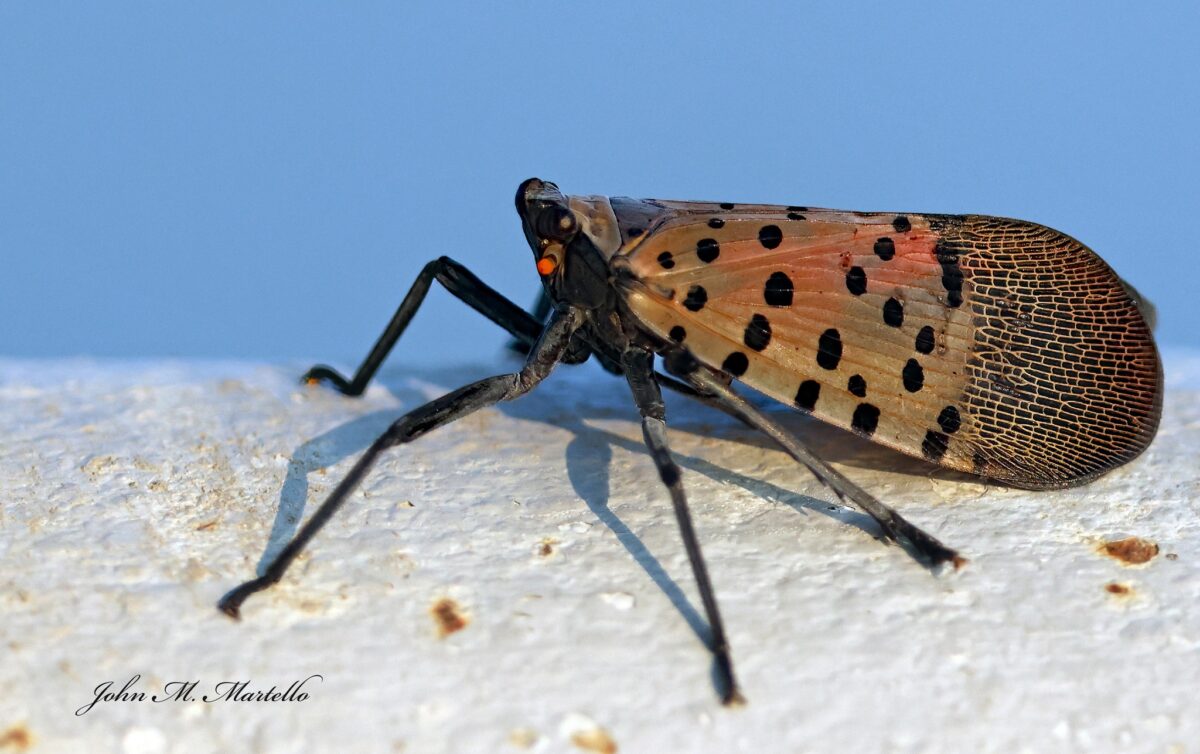
The East End is no stranger to the appearance of invasive insect species. The newest member of this club is the spotted lanternfly, which is making its away across New York State and onto Long Island.
Known for its distinctive red torso and black spots that cover its wings and body, spotted lanternfly is native to China and Vietnam and was first found in the United States in Pennsylvania in 2014. Six years later, the insect was first found in New York on Staten Island in August 2020.
While most of the sightings of the insect have been in upstate New York, Chris Logue, the director of the division of plant industry at the New York State Department of Agriculture and Markets, confirmed that population clusters of adult spotted lanternflies have been found in East Hampton and Jamesport, the first sightings on the East End.
Logue noted that what makes spotted lanternflies particularly hard to monitor is how easily they can be transported. Spotted lanternflies often attach themselves to different parts of vehicles, including in wheel wells and front grills, near windshield wipers, in gas caps and even inside the cabin. The insects can also lay egg masses on cars, RVs, boats and boat trailers as well.
“This is really, really challenging to deal with from the standpoint that the adults will hitchhike on various types of vehicles and that the egg masses can be laid on a lot of different types of things that will get transported,” Logue said. “And so you see long-distance jumps.”
Combating spotted lanternflies has also been hampered by the lack of information on the insect available when it was first found in the United States, with Logue noting that “the research community has really been trying to catch up with that over the past several years so that we can have better solutions for it going forward.”
Logue said that spotted lanternflies are mainly “a nuisance pest for the homeowner” and in most cases won’t causes significant damage for common trees and shrubs in yards.
But the main target of concern is vineyards, as the insects can cause significant damage to the grapevines. This damage is usually not visible at first, as most of it occurs structurally inside the plants.
“They’re actually tapping into the pipework of the tree, and they’re extracting sap, which can be really harmful for our grapevines, especially when they’re feeding late in the season,” said Brian Eshenaur, a senior extension associate at the New York State Integrated Pest Management Program at the Cornell University College of Agriculture and Life Sciences. “They’re removing so much sap that the plant doesn’t have the reserves to adequately survive the winter. And so that following spring, they might not come back.”
To combat the impact of spotted lanternflies, the Agriculture and Markets Department has been taking measures to reduce the effects and spread awareness to the public about the insects.
In livestreams on Instagram and Facebook on August 1, state employees discussed their efforts so far and explained what homeowners can do when they encounter spotted lanternflies in their yards.
The easiest method of removing spotted lanternflies is simply by sucking them up with a vacuum. Scott Litwin, a horticultural inspector with the Division of Plant Industry at the Department of Agriculture and Markets, said that this is the same method that inspectors like himself use when they find spotted lanternflies, as each inspector carries a backpack vacuum with an extended handle. He explained that the centripetal force in the back of a vacuum canister crushes and kills the insects and that this has been an effective method so far.
“They’re easy for us to spot when we do find them,” Litwin said. “And they’re in such numbers and dense masses that this simple backpack vacuum will drastically reduce the numbers in a set infestation that we find.”
Litwin also said that certain inspectors use drones to spot clusters of lanternflies that they can’t view from the ground or that are in locations that are dangerous for inspectors to access.
“It allows us to get places that we couldn’t get on foot, whether it’s high up in a tree, in a deep ravine or along railways or truck strops where it’s dangerous to be,” said Collin O’Brien, a state horticultural inspector who is a certified drone operator.
Litwin and O’Brien also demonstrated how to remove egg masses by scraping them off with a putty scraper, though this can also be done with a credit card. Litwin said that when scraping, homeowners should make sure “that you’re scraping with a little bit of firmness so you really crush the eggs and you’re not just popping them off of the surface where you find them.”
Additionally, the Agriculture and Markets Department has a public reporting system where anyone who spots a spotted lanternfly can report it to them, which Litwin and O’Brien encouraged.
“We’re looking for all hands on deck for this,” Litwin said. “Spotted lanternfly has a big economic impact on agricultural commodities. New York is the No. 1 grape producer east of the Mississippi and people like their grape juice, grape jam and wine, so we don’t want to interrupt that.”